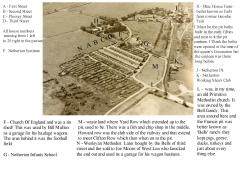.jpg.cdd7f8371d17e2f2f2e2a0e21e02f727.jpg)
Canny lass
Supporting Members-
Posts
3,598 -
Joined
-
Last visited
-
Days Won
409
Content Type
Forums
Gallery
Events
Shop
News
Audio Archive
Timeline
Everything posted by Canny lass
-
.... tanker?
- 1 reply
-
- 2
-

-
That could be an interesting rummage in the deep, dark cellars of the English language in particular and of Bedlington history in general! Challenge accepted!!
-
Now you're giving your age away!
-
.... and it looks like she's a very good one! Looks almost too good to eat! Am I missing something about Newcastle Utd?
-
This is more exciting than Dallas and Falcon Crest put together! (Yes, I know, I'm giving my age away there!)
-
.thumb.jpg.7493ddab4a696108cf2b849323d3c155.jpg)
Village Map with text2.jpg
Canny lass commented on Alan Edgar (Eggy1948)'s gallery image in Historic Bedlington
Hi Sheila, welcome to the forum! I'm afraid Netherton Colliery is long gone, but I can point out the 'mission' where your father was baptised. It was still active during my early childhood but later became a garage/workshop for a small haulage business. It was located next door to the school and labelled 'Mission Room' on this 1921 map. It can also be seen in this aerial view (though now in use as a haulage yard). It's the light coloured building at right angles to the houses with the school on its left. -
Thanks HPW! I've still got a few gaps to fill on the Hedley tree so I'll be having a look at Eddie and Phil to see what i can find out.
-
There's hope yet, then?
-
Such a pity - no roots in Cramlington or Bebside. Hope you didn't mind me asking. ... and welcome to the forum.
-
Hello @SouthernGeordie, I'm always interested in the name Hedley. I don't suppose you have any roots in Cramlington or Bebside?
-
Thank heavens for that bit of good news! I know it can be tough when your nearest and dearest is in ill-health but don'y forget to make time for yourself. It's important.
-
Well, that went downhill at a fair rate of knots! It's just 6 months since they were shouting about the first material being delivered and now it's all over.
-
Can you just confirm that you got my message with 2 pages of info? I have conflicting info here and in messages, both sent 1 hour ago.
-
Perhaps we are talking about two different things! I'm talking about the messaging service on this site, not e-mail. It's the top of this page you should be looking at. let me know if you don't find it and i'll see if one of our members can help you.
-
Top of the page, right hand corner you will see a small, black bell and a black envelope. Click on the envelope and a list of your messages will appear. Click on my message to open it. Once opened, you can click on the two attached pages I've sent you.
-
I should mention, that the info on page 2 relates directly to Mary Ann Giles, but the rest is common to all mentioned on page 1.
-
@Linray I've sent you the information I mentioned earlier.
-
Hi again @Linray, I'm afraid I don't have the census return from 1921 for your father, only a transcript of it as I access the 1921 census through a friend. I'll send the transcript to you but it also contains a few of my 'scribbles'. From info gleaned from my friend, your grandmother, Jane Isabella, seems to have married (Lavery, living Stakeford) and in 1921 has one daughter, Daisy. She thinks that Mary (full name Mary Alice Cropp Giles) was adopted by a couple in Blyth, surname Francis. 'Cropp' is probably the father's name just as Forster is the father's name in the Giles family. This was very common practice. You will see on the 1921 census transcript that even Mary Ann Giles has had a name added - Cavagin - and this is probably her father's name. This should give you a few streets to go down in your search. I'll scan the 21 transcript and get it off to you some time today.
-
Hi @Linray If you go back to the posts of July last year you'll find that I researched Forster Giles for you then and found what I believed may be the family you were looking for in Bebside Furnace. There was no ”Forster Giles” in the 1911 census but the head of the household, a widower, and his 17 year old son both had the surname Giles. Living in the same dwelling was Isabella Forster, widow, housekeeper to the afore mentioned. There were also 6 ”boarders” ranging in age from 3 to 16. The two oldest borders also had the surname Giles and I presumed these to be Isabella’s children. The remaining 4 boarders aged 3 to 12 also had the surname Giles but had been given the middle name Forster. I presumed then, rightly or wrongly, that these were the result of ’extra- curricular’ housekeeping duties – a not uncommon practice at the time, if surnames in the area are anything to go by. The 21 census is indeed available and there I can see that family has moved to Bedlington Station and is recorded as living at at 27 B(ack) Clayton Street, Bedlington (Station). The head of the household in 1911, Robert Forster, for whom Isabella Giles was a housekeeper, is not there. He may have died or Isabella may have moved. Isabella, now the head of the household, is still recorded as a widow, but it may be that she is now a widow for the second time ,if she had married Robert Forster in the intervening 10 years. Of the six ”boarders” in 1911, the oldest girl, now about 26 years is not recorded and neither is the oldest boy, now about 22 years old. They may be married or working away from home which was common. The remaining four, all single and now aged 14, 15, 16 and 24 are resident and their relationship to Isabella now becomes clear as all are recorded as sons and daughters of Isabella, which suggests my theory on paternity may just be correct. There is also an addition to the family which will certainly be of interest to you - Forster Giles, born Bebside, aged 5 years is recorded as Isabella’s grandson. He bears the surname Giles, having Forster as a first name. He may be the illegitimate son of Mary Ann Giles, 24, still single, living with her mother and working as a brick maker ath the Bedlington Station brickworks. He may also be the legitimate son of any of Isabella’s sons visiting his grandmother, Hope this helps.
-
There are many ways to skin a cat! My OH, the first one, has taken off his hat and is bowing reverently to a fellow Aberlour admirer!
-
Fantastic photos. Don't think I've seen any of them before!
-
Congratulations Eggy! That hat doesn't half suit you! Does this mean that you are now my 'other ' other half? Thank you kind sirs! I am again honoured and humbled to receive this prestigious award. Looking back over the last year and thinking of people people who have impacted my life in a positive way, you, my dear friends, are some of those people. Therefore, I would like to share this prize not only with Eggy but with all of you and thank for your contributions to the site. Naturally, a thank-you speech wouldn’t be a ’proper’ speech if it didn’t also convey a sense of gratitude to others who have helped along the way. To that end, I would now like to thank, in no particular order of importance: My tap-dancing teacher, June. My OH who listens patiently to my ramblings about all things Bedlington. My next door neighbour (I use the expression ”next door” in its vaguest meaning as it’s 2km away). The people of Ashington, Cramlington, Blyth and Morpeth who nurtured my love of leisure and physical activity. Postman Pat. My father and his fellow leek-growing enthusiasts who taught me that asking two questions was always better than asking only one. My mother, for teaching me to understand that the real honour lies not in winning but in taking part. I’m still grateful to Esther at the corner shop and equally grateful to Geordie Collis the colliery ’poliss’ for something or other. A special mention goes to: My hairdresser, for all her efforts to achieve the impossible. B.U.D.C Billy the butcher. King Charles III The walruss and the egg man. The Encyclopedia Britannica. Tommy Cooper … … and last but by no means least, my cats, Tickle and Pint-Pot. Thank you all once again!
-
Happy birhday to you Happy birthday to uou Happy birthday dear 3g Happy birthday to you! Sung to the tune of 'Happy birthday to you'. Hope you are enjoying your day,
-
I know I'm a bit early but I've guests arriving in a half hour. Ladies and gentlemen! This is the chief stewardess speaking! All passengers travelling on flight number 2023 should now prepare for exit through gate number 2022. On behalf of the captain and his crew I welcome you on board. The journey will take 12 months, our ETA is midnight 2023 and your captain, Andy, and his crew do not expect any delays that cannot be overcome by twiddling the right knobs, pulling the right levers and possibly recruiting the help of a higher power – 3g. No grief, disappointment or negativity will be allowed on this flight! This should be left in the waste-bin provided to the right of the exit at gate 2022! We may meet a little turbulence during the flight but this usually lasts for a short while only. However, it is advisable to keep your seat belt fastened and at least one hand over your drink throughout the journey. On board this flight we will be serving a simple meal comprising: friendship, Bedlington history, a bit of good old-fashioned banter, a modicum of common sense and (if the cook hasn’t been at the sherry) a lot of laughs. Our journey towards the future goes by way of Good Health, Good friends, and Happiness. I wish you all a pleasant journey through 2023. Enjoy the flight and please press the button over your head to call my attention if you need my assistance but woe betide anyone who disturbs my snacking /drinking in the galley kitchen situated to the rear of this aircraft. Have a good one! P.S. I’m not making resolutions this year. No one likes a skinny, sober bitch anyway.
-
Well spotted! I believe the Infant school and junior scchool were in the same building, therefore I'm suggesting the larger of the two schools (Bebside was well populated at that time and families were large). Speaking of time, I see I wrote 1909. That should have been 1906. Sorry. The school records show my father admitted to the school May 1906. He was then 5½ years old. Two years later he was "transferred to Boy's Dept". The same seems to apply to all pupils - 'moved to boys dept or to girls dept'. The head teacher was the same and the word 'dept' suggests the same building.


